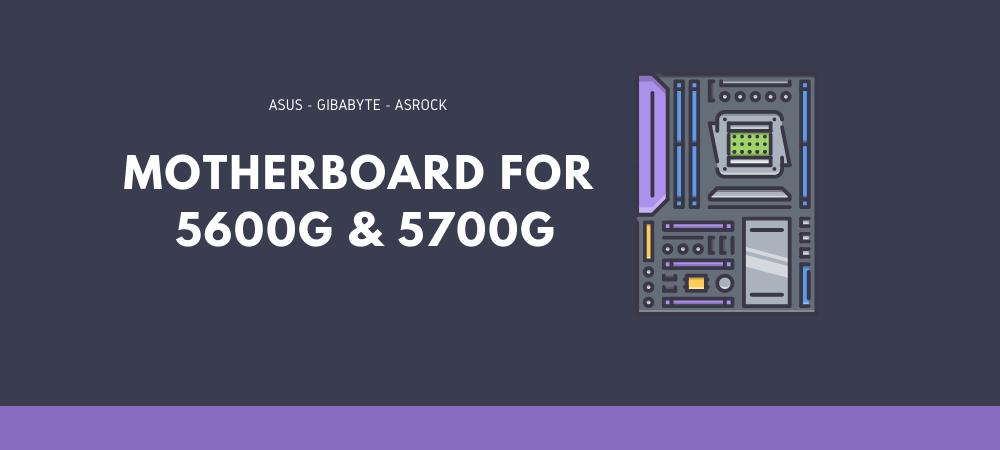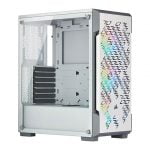A motherboard is of the most underrated components of a PC. It doesn’t directly affect your PC’s performance which is why many people try to ‘save money’ by installing for a low-quality board.
But this is a wrong approach as motherboard allows other critical components such as CPU and graphics card, to perform at their full potential.
Not only that, a motherboard determines things what CPU you can install in your PC, how much overclocking you can do to your CPU and RAM, how many graphics cards you can use at one time, how many SATA/M.2 devices you can connect, etc.
Therefore, you must do a proper research before going for any new motherboard model.
Best Motherboards for Ryzen 5600G and Ryzen 5700G
Table could not be displayed.AMD has recently released Ryzen 5600G and 5700G APUs. Below are our favorite picks as the best motherboards for these APUs.
Like PC cases, motherboard comes in ATX, mATX, and mini-ITX form factors. This is why we’ve included at least one option from each of these types.
So, without any further delay, let’s start.
1. ASRock B550M-ITX/AC: Best mini ITX Motherboard for Ryzen 5600G and 5700G
No products found.
The ASRock B550M-ITX/AC is the first motherboard in this roundup.
At first glance, it may look weird to you. No, it’s not the 6+2 VRM setup, smaller VRM heatsink, or single-latch design of DIMM slots. All of them can be justified by the lower price tag this mobo comes with.
Instead, it’s the placement of the 8-pin CPU connector on the rear I/O panel!
And it doesn’t end here.
It comes with three 4-pin fan headers: two of them can be found above the socket area, while the last one is located on the bottom right area.
The 24-pin ATX connector and SATA ports are placed on the right side of those DIMM slots – again a poor design choice. Below these connectors, you’ll get USB 3.0 header, a USB 2.0 header, and the front panel header.
It comes with single PCIe x16 slot (without any steel reinforcement) that can be found on the bottom area.
Above this slot, you’ll get the single M.2 slot operating at x4 mode. This M.2 slot and X570 chipset have a combined heatsink. On the left side of PCIe x16 slot, you’ll get the older ALC887 audio codec.
The rear I/O panel comes with a DisplayPort, HDMI port, two USB 3.2 Gen 1 ports, two USB 2.0 ports, one Type-A USB 3.2 Gen 2 port, one Type-C USB 3.2 Gen 2 port, 802.11 ac WiFi antennas, and Gigabit Ethernet port. You get an I/O shield too, but it doesn’t come preinstalled.
Weird design choices aside, this board has all the bases covered.
The 6+2 power phase design is more than enough for 5600G and the small-sized VRM heatsink allows you to install even the biggest air coolers in the market. There are a very few mini-ITX models on AMD platform, and this is probably the cheapest of them all.
2. ASUS TUF Gaming B550M-PLUS: Best Micro ATX Motherboard for Ryzen 5600G and 5700G
No products found.
When it comes to motherboard form factor, many PC builders think micro-ATX to be perfect as it gives you the middle-ground between ATX and mini-ITX options.
They carry beefier specs than mITX boards and are smaller than full-ATX models.
Being generally cheaper than their ATX/mini-ITX siblings, such boards are generally sought after by budget users.
These are the reasons why our next pick is the Asus’ TUF Gaming B550-PLUS – a B550 mATX board.
The first thing you’ll note here are the relatively smaller VRM heatsinks on the top area. This board comes with an 8+2 power configuration with 50A Vishay Sic639 MOSFETs. While this is not the best power delivery combo in the market, it’ll be good enough for overclocking 5600G and 5700G APUs.
The left heatsinks is further extended over to the rear I/O panel and has some yellow/gray patterns on top that blend well with the black/grey color scheme on the PCB.
The header placement is similar to what you get in other boards: single 8-pin EPS connector between the left and top VRM heatsinks, an RGB and two fan headers above the DIMM slots, and a 24-pin ATX power connector along with a front-panel USB 3.2 Gen1 header on the right side.
The remaining headers such as front panel audio header, 3-pin aRGB connector, chassis fan header, and speaker header can be found at bottom of the board, along with vertical SATA connectors.
On the lower area, you’ll find two full-length PCIe x16 slots (only AMD Crossfire is allowed) and one x1 slot. You also get two M.2 2280 slots here.
While both of them are compatible with 80mm-long PCIe/SATA-based devices, only the top end is wired to the CPU and operates on PCIe 4.0 x4 mode. The lower slot operates at regular PCIe 3.0 x4 mode.
If we talk about the rear I/O panel, you get 4 USB 3.2 Gen1 ports, two USB 3.2 Gen 2 ports (one type-A and one type-C), two USB 2.0 ports for older hardware, along with a DisplayPort and an HDMI port. You also get a BIOS flash button that can help you update the BIOS without using the CPU.
On the connectivity side, you get WiFi 6 and 2.5 GbE port as well.
As you can see, Gaming B550M-PLUS comes with many high-end perks despite being a mid-ranger and can surely complement the Ryzen 5600/5700 APUs in an mATX-based build.
With that said, there are some drawbacks that need to be highlighted.
First of all, the I/O shield doesn’t come preinstalled. You would have to fit by it yourself which can increase the installation time slightly. Then we have the Realtek’s S1200A audio codec. It’s not necessary a bad choice but many motherboards from same price range have better onboard audio solutions.
3. Gigabyte X570 AORUS Elite: Best ATX Motherboard for Ryzen 5600G and 5700G
No products found.
Gigabyte X570 Aorus Elite is the first X570 motherboard of this roundup. Coming in at slightly more than 200 bucks, it sits in the middle of Gigabyte X570 motherboard hierarchy.
Unlike previous boards discussed, it comes in an ATX form factor. It comes with an all-black PCB with some diagonal patterns on heatsinsks and other areas on the bottom side.
And it’s not just the PCB. You can find this color on DIMM slots, PCIe slots, SATA ports, and on EPS/ATX connectors as well. This overall dark theme will help the Aorus Elite blend well with virtually any PC build you can think of.
Both VRM and chipset heatsinks come with aluminium brushing along with AORUS branding.
Although you get RGB in areas like under the I/O shroud and on the bottom-left side, it doesn’t look like a gaming motherboard at all.
Partly because of its ATX form factor and partly due to good placements, Aorus Elite looks quite spacious.
It has four fan headers and all of them support PWM as well as DC-controlled fans. While three of them can be found at the top, the last one is located above the main M.2 slot.
Speaking of which, there are two M.2 slots supporting devices up to 110mm length. There’s no difference between them except that the top one has its own heatsink.
On the right side, there are four DIMM slots with double-sided locking mechanism for secured fit.
Being a relatively premium motherboard, Aorus Elite comes with three PCIe 4.0 slots: two PCIe full-length slots and one PCIe x1 slot.
The main PCIe slot is located below the main M.2 slot, is steel-reinforced, and operates at x16 speed. The bottom PCIe full-length slot is connected with the chipset, is no reinforced, and operates at x4 speed.
This board also comes with BIOS Q-flash feature, using which you can updated your BIOS without using any CPU. As it was released in 2019, you’ll have to update the BIOS to make it compatible with Ryzen 5000 processors.
The VRM is one of the biggest strengths of Aorus Elite, as it comes with a 6+1 Infineon IR35201 controller that uses phase doublers.
So essentially you’re getting a 12+2 Vcore/SoC setup that can handle any ryzen 5000 processor, let alone the 5700G.
The only drawbacks we could find in Aorus Elite is the lack of Type-C port in the I/O panel (you do get ten USB ports overall though) and no debug LEDs.
Ryzen 5600G & 5700G Motherboard Compatibility FAQ
What motherboards are compatible with Ryzen 5600G and 5700G
As Zen-3 based 5000-series processors, the ryzen 5600G and 5700G are compatible with motherboards based on X570, B550, and A520 chipsets.
What motherboard should I get for Ryzen 7 5600G and 5700G?
If you are OK with little/no CPU overclocking, then a budget B550 motherboard will be good for you. But if that’s not the case, you should an X570/high-end B550 motherboard instead.
Is 5700G good for gaming?
Yes, the 5700G comes with 8 CPU cores and Radeon Vega graphics that can play many AAA titles (Such as GTA V) at 720p resolution, or at 1080p on low preset, which is quite impressive for an integrated graphics unit.



